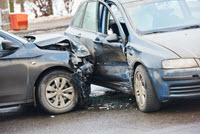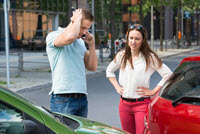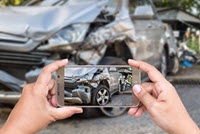Can Multiple Car Accidents Cause Insurance to Turn You Away
⊸ Blog⊸ At-fault Accidents In Ontario And How They Impact Insurance
Oct 19, 2020
Car accidents happen. But, whether or not you are the one at-fault and how it will impact your car insurance can be a grey area. It's a topic drivers need to and want to know more about. Before we get into the details about at-fault accidents, drivers need to know one crucial thing when getting into an accident – never admit fault at the scene. If possible, don't discuss it with the other drivers involved. Document what happened, take photos, get witness contact information, and follow the instructions of the police or head to the accident reporting centre. Learn more about what to do when you get into an accident in Ontario. Being at-fault is exactly as it sounds – you are the driver who is responsible, or the cause of an accident. For example, you are the car that initiated contact or failed to stop in time. The amount of fault for which you are responsible is determined by your insurer. They will perform an investigation. Someone will always be found to be at-fault, whether it's fully or partially. You can be found anywhere from 0% to 100% responsible. One thing that many drivers are unaware of is that at-fault applies to all drivers. The Insurance Bureau of Canada explains : Who is at-fault for an accident is not always clear right initially. There are many factors that go into fault determination. Who's involved, where they were driving, speed, road conditions and more all play a role. . Fault determination rules were created to help insurance companies, police and others involved determine who is at-fault, and how much fault they share. Fault is determined by your insurer. To do this, they use the Fault Determination Rules that were created under the Insurance Act to investigate the accident and assign fault. The Financial Services Commission of Ontario explains : After you report an accident, the company will investigate the circumstances and then make decision based on the accident fault determination rules in Ontario. Fault determination rules cover many different accident types and driving situations : Fault is allocated to each driver based on which scenario most closely resembles the accident. If any of the scenarios do not describe the accident, then the fault is allocated according to the ordinary negligence law rules. Want to learn more about the fault determination rules? Visit the Service Ontario website. Contrary to popular belief, the police do not impact your insurers' decision to assign fault. If you are charged with a traffic offence as part of your accident, you will not necessarily be deemed to be at-fault. On the other hand, if the police decide not to file charges, you can still be responsible for the crash. FSCO provides a good example : You have the right to disagree with the fault determination. This is why it's so important to document everything. You can appeal the decision and state your case to your provider. All companies have an appeal process in place. A third-party mediator may also be brought in to make a final determination. There are many different types of car crashes and accidents that you could be involved in when driving – sideswipes, T-bones, head-on incidents, multi-car pile-ups and more. In total, there are 40 common types of car accidents that are used to determine fault. However, there is a difference between getting into an accident and being the cause of one. Here are the top types : This is perhaps the easiest to determine fault. If you rear-end another vehicle, then you will most likely be found at-fault. Whether the vehicle comes to a sudden stop, is stopped at a traffic light, or even stopped on the side of the road, the vehicle that makes the initial contact is most commonly the cause. If multiple cars rear-end each other, each vehicle that hits the car in front of them will usually share some of the fault. If you are involved in an accident, and no other drivers are involved, you will be at fault for it in most instances. Common types of single driver accidents include causing damage to public property, crashing into a parked vehicle, hitting a tree and hitting a pedestrian. Even if the cause is poor road conditions, or you swerve to avoid an animal or something else on the road, you will still be found guilty. If you fail to abide by the rules of the road, then you will most likely be found to be at-fault. This includes running a red light, failure to signal when changing lanes, or disobeying a posted traffic sign and causing an accident with another vehicle that was following the rules of the road, regardless of who made the initial contact. In most situations, the vehicle making the lane change or entering a lane of traffic is at-fault. This includes changing lanes, turning into a lane of traffic, merging onto the highway, and any other situation when a vehicle moves across the line. A T-bone accident, or side-impact, can happen in many situations. It most frequently happens at intersections. Depending on the situation, either driver could be to blame. It often comes down to which driver had the right-of-way and if a traffic violation occurred. Taking your eyes and attention off the road for any reason will make you at-fault. Distracted driving is one of the leading causes of accidents and deaths on our roadways. If you are found to have been texting, using your phone, or engaging in any activity that is deemed to be distracted driving, then you will most likely be found to be at-fault. Driving while impaired will immediately qualify you to be at-fault if you are involved in an accident. These are some of the most common incidents; however, regardless of the type of accident in which you are involved, there is a chance that you could be found to be fully or partially at-fault. If you are found to be at-fault, you can expect your insurance to increase. You may be able to minimize the amount if the accident was minor or if you have accident forgiveness. Now for the all-important question – how much does it go up if you are found to be the cause of an accident? Well, it depends on a number of factors, such as : If you've had a number of at-fault accidents, you may need high-risk auto insurance. Yes. If you are involved in an at-fault accident you could see an increase. However, if you share less than 25% of fault in causing it, you will not likely see an increase. If you get into a non-fault accident and are not to be the cause of the crash, your insurance will not likely go up. It is a common myth that it will automatically change if you file a claim. As of June 1, 2016, insurer cannot increase your costs for your first minor at-fault accident within a three year period. There are certain criteria that must be met. The FSCO explains : The same rules apply to G2 license holders. If you get into an accident and you are at-fault, you will see your insurance increase. Since you are considered a novice driver, your rates will be higher, and you could have issues getting coverage. Driving without insurance in Ontario has serious repercussions. If you cause an accident and do not have insurance you will be held personally responsible for any repairs to your vehicle. You will also have to cover you own medical bills. You will be fined and could face charges depending on the circumstances. What happens if a pedestrian caused an accident or a pedestrian ran in front of your car? The same rules apply in determining fault as if two vehicles caused it. Your company will use the fault determination rules to assess responsibility to the incident. There are several common situations where pedestrians can be found to be at-fault, even if they are not hit by the vehicle or injured. They include : Being involved in an accident is bad enough. But, getting into an accident that is not your fault and with an uninsured driver can complicate things. The good news is you are covered. All policies in Ontario include uninsured automobile coverage. This protects you in instances you are involved in an accident with someone who is driving without insurance. You will deal directly with your provider and they will compensate you for damage and medical costs. Once you make sure everyone is okay at the accident scene, file a police report, take your vehicle to the reporting centre, and contact your insurance company. Don't admit fault. If you are found to be at-fault, expect a change in premium or possible denial when it is time for your car insurance renewal. If you have an accident on your record, it's now more important than ever to compare quotes to find coverage and keep costs down. If you involved in a not at-fault accident you will still be required to file a claim. The claims process works the same as if you are responsible. You report your accident at your local reporting centre, notify your agent or advisor and fill out the required paperwork. Yes. Your insurer will cover you if you are at-fault for an accident for repairs and medical costs. You will be required to pay your deductible. Accidents stay on your insurance for six years. Some insurance companies check as far as ten years back. Determining fault becomes more complex when more than two vehicles are involved, such as multi vehicle accidents. There are many factors at play in an intersection accident. Whether or not the light was red, a driver was turning left, traffic violations occurred, and more need to be considered to assign fault. Tire blowouts happen all the time. In general, tires are not covered by your policy. A blowout itself may or may not be considered an accident, especially if no other vehicles are involved. The nature of the blowout will also be considered – it could be caused by debris or a manufacturer defect. Fault is determined on a case by case basis. No-fault Insurance In Ontario <<A Guide To Getting Ontario Custom Licence PlatesLease Takeovers And How They Work In Ontario>>Your Guide To At-fault Accidents

Am I at-fault?
This is one of the first things that goes through your mind when you get into an accident. This is quickly followed up with, " How much will it impact my insurance, and "should I admit fault in a car accident?"
Don't Admit To Being At-fault If You Get In An Accident
What Is An At-fault Accident?
At-fault Collisions Apply To All Drivers
When you lend your car to someone, you also lend that person your insurance. If the person who borrows your car has an at-fault while driving it, their accident goes on your record, and your insurance could go up.
How Is Who's At-fault Determined In A Car Accident?
Your Insurer Determines Who's At-fault In An Accident
What Are The Insurance Fault Determination Rules For Accidents?
Do The Police Have Anything To Do With The Insurance Company Fault Assessment?

For example, if a vehicle was unable to stop on an icy road and rear-ended another, a police officer may say that neither of the drivers was at-fault. Such a comment relates to the laying of charges and should not be taken as an opinion about how the fault determination rules apply to an auto insurance claim. In a case like this, the insurer would apply the rule stating that a vehicle that rear-ends another is at-fault.
How Do You Dispute If You Been Determined To Be At-fault?
What Are The Most Common Types Of At-fault Accidents
Rear End Collision
Single Driver
Failure To Obey Traffic Signs
Changing Lanes
T-Bone
Distracted Driving
Impaired Driving
How Does An At-fault Accident Affect Insurance?
How Much Does Your Insurance Go Up After An At-fault Accident?
Will An At-fault Accident Cause An Insurance Increase In Ontario?
Will My Insurance Increase If I Am Not At-fault ?

What Happens If I Get Into A Minor At-fault Accident?
Insurers can no longer use a minor at-fault accident that occurs on or after June 1, 2016 meeting certain criteria to increase your premiums. The criteria include that no payment has been made by any insurer, that there are no injuries, and that damages to each car and property were less than $2,000 per automobile and were paid by the at-fault driver. This provision is limited to one minor accident every three years.
G2 At-fault Accidents
What Happens If You Get In A Car Accident With No Insurance And Are At-fault?
What Happens In Car Accidents When A Pedestrian Is At-fault?
What Happens If You're In A Car Accident With An Uninsured Driver Not At-fault?
What Do You Do After An Accident That Is Your Fault?
What Do You Do After A Car Accident This Is Not Your Fault?
At-fault Accident FAQs
Here Are Some Other Articles You May Be Interested In
A Guide to the Ontario Graduated Driver's Licensing System
A Simple To Follow Guide For How To Buy A Used Car
Can Multiple Car Accidents Cause Insurance to Turn You Away
Source: https://www.thinkinsure.ca/insurance-help-centre/at-fault-accident-and-impact-on-car-insurance.html